
The LONDON TRANSPORT D classThis page created 17th December 1999, by Ian SmithRelaxed Duple Daimlers: D132-D181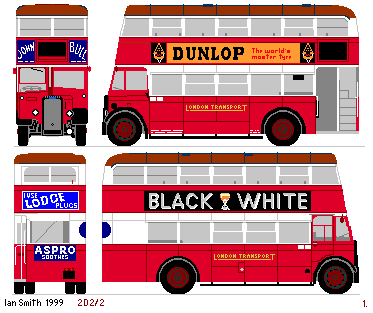 By mid-1945 most bus operators in the UK were looking forward to a resumption of peacetime supplies.
However, their preferred suppliers, AEC and Leyland, were still busy producing tanks and military vehicles.
Bus production was still firmly with Guy and Daimlers, with a few Bristol chassis now around.
Rather than buy utilities, even the "relaxed" versions now available,
most companies adopted a wait and see policy, and the Ministry of Supply
found that it had ordered production of hundreds of buses that suddenly no-one wanted.
London Transport was approached to see if it wanted an extra hundred buses,
and after initially saying no agreed to take fifty,
provided that they were bodied by Duple rather than Massey.
The board had realised that it could use them to reinstate the double-decker
GreenLine services to and from Romford.
By mid-1945 most bus operators in the UK were looking forward to a resumption of peacetime supplies.
However, their preferred suppliers, AEC and Leyland, were still busy producing tanks and military vehicles.
Bus production was still firmly with Guy and Daimlers, with a few Bristol chassis now around.
Rather than buy utilities, even the "relaxed" versions now available,
most companies adopted a wait and see policy, and the Ministry of Supply
found that it had ordered production of hundreds of buses that suddenly no-one wanted.
London Transport was approached to see if it wanted an extra hundred buses,
and after initially saying no agreed to take fifty,
provided that they were bodied by Duple rather than Massey.
The board had realised that it could use them to reinstate the double-decker
GreenLine services to and from Romford.
The buses were to the relaxed standard seen on the lowbridge buses, with rounded roof domes, no hopper ventilators and nearside destination blinds. Thirty-eight of them had AEC engines (2/1D2/2), and the remaining twelve Daimler engines (2D2/2). The first one, D132, with an AEC engine, plus all the Daimler engined examples, were painted red and white and sent to join the fleet at Merton.
The revitalised GreenLine network introduced a summer service between Marylebone Station and Whipsnade Zoo, the 726.
Initially this operated with Regal 10T10s from Watford (WT),
but by July 1946 Romford was running some of the service with buses that had run in on service to Aldgate.
The summer of 1947 saw the 726 service allocated officially to Romford,
which had some rear-entrance STLs allocated for it.
In practice the STLs worked as a mixed fleet with the Daimlers.
Whilst this cycle was underway the STLs allocated for the 726 were called away for conversion to SRT,
and five Brush-bodied Daimlers from Merton were overhauled and given the GreenLine treatment.
They introduced a two-tone green colour scheme,
which was then adopted for the Duple Greenliners as they went through overhaul.
It had been suggested that they go to join the others at Merton,
but this had been vetoed by the Central Area Union representatives,
who were a little agrieved at the proportion of the new RTs going to the Country Area.
A proposal that they be distributed around the Country Area was also
thought a non-runner, due to the problems of introducing a "new" old type
to many garages.
The Romford Six went into store at the end of the Whipsnade season,
but reappeared for Christmas and the New Year sales, helping out the RTs on the 721 and 722.
But after this Indian winter, they too went to join the others at Merton at the end of January 1951.
Meanwhile the original red buses had been losing their Daimler engines at overhaul, gaining AEC replacements
(there were plenty from withdrawn STLs!). These too were gaining the red with cream band livery,
but not all made it to second overhaul and continued in red and white to the end.
This came during 1953 and the beginning of 1954, when they were all withdrawn for sale.
Naturally the always-red buses were seen as a better bet for purchasers,
and sold better than the ex-GreenLine examples,but the great majority went to new homes with the usual customers.
|
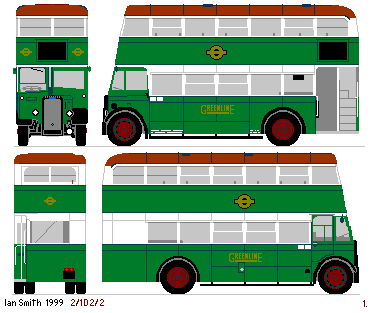 The remaining thirty seven had Lincoln green instead of the red paint,
and Green Line totems in place of adverts.
After reception during November 1945 they went into store
(at Grays, Epping, Northfleet and Romford),
ready for the restart of GreenLine operations at the beginning of March 1946.
All were allocated to Romford (RE),
and were fitted with full-depth blinds for the 721 and 722 services.
The 721 service from Aldgate to Romford and Brentwood began in March,
and the 722, Aldgate to Hornchurch, Upminster and Corbets Tey, in April 1946.
Blinds were initially white written on black,
but the GreenLine standard was changed in May 1946 to amber backgrounds with black writing.
The remaining thirty seven had Lincoln green instead of the red paint,
and Green Line totems in place of adverts.
After reception during November 1945 they went into store
(at Grays, Epping, Northfleet and Romford),
ready for the restart of GreenLine operations at the beginning of March 1946.
All were allocated to Romford (RE),
and were fitted with full-depth blinds for the 721 and 722 services.
The 721 service from Aldgate to Romford and Brentwood began in March,
and the 722, Aldgate to Hornchurch, Upminster and Corbets Tey, in April 1946.
Blinds were initially white written on black,
but the GreenLine standard was changed in May 1946 to amber backgrounds with black writing.
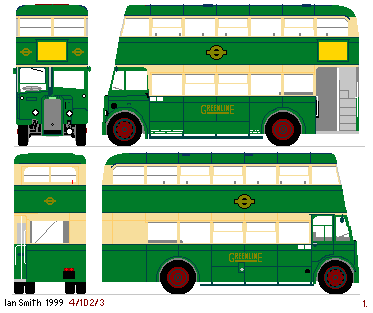 The autumn of 1948 saw the Daimlers starting on overhauls.
This produced a livery change, with the white replaced by deep cream,
and the roof, mudguards and guard-rails now in green.
The overhauled buses also received heaters, bringing a classification change to 4/1D2/3.
The autumn of 1948 saw the Daimlers starting on overhauls.
This produced a livery change, with the white replaced by deep cream,
and the roof, mudguards and guard-rails now in green.
The overhauled buses also received heaters, bringing a classification change to 4/1D2/3.
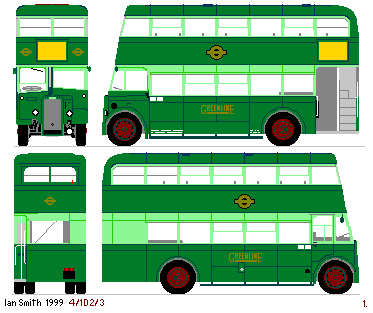 The 726 service was adjusted to start from Baker Street,
and the Daimlers kept roaring in and out through the East End with its cobbled streets.
By August 1950, after about 250,000 miles each on this route, they had had enough.
They were replaced by a batch of
The 726 service was adjusted to start from Baker Street,
and the Daimlers kept roaring in and out through the East End with its cobbled streets.
By August 1950, after about 250,000 miles each on this route, they had had enough.
They were replaced by a batch of
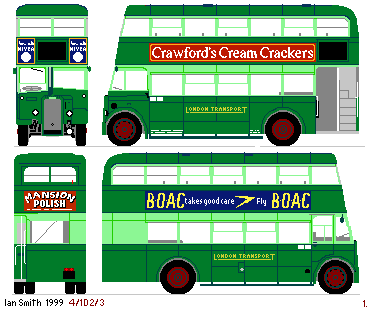 So 31 went into store, just over four years old with just a quarter-million on the clock.
This left six licensed for the Whipsnade service.
When the staff at Merton heard about the stored buses,
they asked if they could have them in place of some of their decrepit STLs.
A trial showed them not to be in the official "clapped-out" state,
and they were duly transfered.
Perhaps because this was an idea mooted from the grass roots, rather than from on high,
the transferees were not repainted, except to lose their GreenLine insignia
and gain "London Transport" fleetnames.
Daimlerland had a new colour to brighten up the Surrey suburbs.
So 31 went into store, just over four years old with just a quarter-million on the clock.
This left six licensed for the Whipsnade service.
When the staff at Merton heard about the stored buses,
they asked if they could have them in place of some of their decrepit STLs.
A trial showed them not to be in the official "clapped-out" state,
and they were duly transfered.
Perhaps because this was an idea mooted from the grass roots, rather than from on high,
the transferees were not repainted, except to lose their GreenLine insignia
and gain "London Transport" fleetnames.
Daimlerland had a new colour to brighten up the Surrey suburbs.
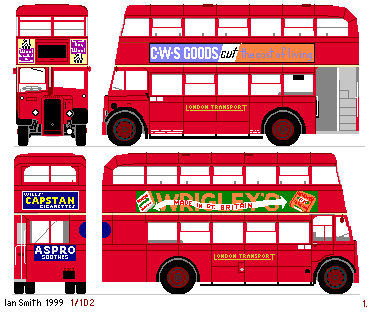
 bus histories
bus histories Ian's Bus Stop
Ian's Bus Stop Daimler index
Daimler index late lowbridge
late lowbridge